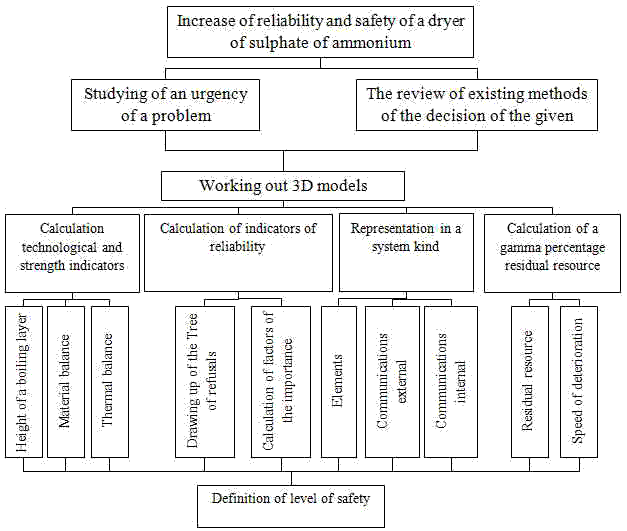

The major problems arising at designing and explantation of the equipment of the chemical industry is maintenance of safe work of the equipment.
Safety – a component of a problem of reliability.
Safety is understood as a condition of security of the person, a society of environment from excessive danger; property of real processes and the systems containing sources of threat and their possible victim to keep a condition with comprehensible possibility of the caused damage from incidents; a condition of objects and systems in the conditions of comprehensible risk; property of system "the person - an inhabitancy" to keep conditions of interaction with the minimum possibility of occurrence of a damage to human, natural and material resources.
Creation of large engineering systems, and also increase of the capacities concentrated in a unit of equipment, does a problem of safety of units more and more actual.
Increase of reliability and safety of any equipment of the chemical industry includes studying of an urgency of the given problem for the given equipment, in my case a dryer of sulphate of ammonium in a boiling layer, and the review of existing methods of the decision of the given problem. It is for this purpose developed 3D model of a dryer of sulphate of ammonium.
Working out 3D models includes calculation technological and strength indicators (height of a boiling layer, material and thermal balances), drawing up calculation of indicators of reliability (drawing up of the Tree of refusals and calculation of factors of the importance), representation in a system kind (to present the unit in the form of elements with all external and internal communications), calculation of a gamma percentage residual resource of a dryer of sulphate of ammonium in a boiling layer (speed of deterioration and a residual resource).
As a result of work level of safety of a dryer is defined.

At exploitation of objects of the chemical industry there is a number of dangers which arise [1,2,3,4]:
because of increase in individual capacity and complexity of units, volumes of transportation of dangerous substances;
because of toughening of technological modes (approach of rates of processes and operational parametres of working environments to maximum permissible, i.e. under abnormal condition-pozharo-explosive);
because of instability of quality of knots replaced while in service and the details, the theory of reliability caused by imperfection;
because of increase of requirements to reaction of "person-operator" of technological process to the regular and supernumerary situations, which possibilities objectively also are subjectively limited;
because of ageing of the basic production assets.
As there is a number of the problems arising while in service such as corrosion of knots and details; deterioration of interfaced surfaces etc.
Deterioration. Wear process of details, knots and interfaces — one of principal causes of exhaustion of a resource. Deterioration in knots and details of a dryer of sulphate of ammonium can be divided into two directions: under the influence of a working environment; deterioration in friction steams [5].
Wear process of rubbing surfaces represents difficult process which includes as purely mechanical (plastic cutting, fatigue damage, etc.), and the physical and chemical phenomena (molecular seizure oxidation of the bared sites of a surface, etc.). On wear process process, except physicomechanical properties of materials the condition of surfaces, pressure, relative speeds of rubbing bodies etc. essentially influence. Wear process mechanisms depend on presence in the field of contact of additional inclusions from temperature and properties of environment. By this time there is only qualitative description and an explanation of all these phenomena, and also separate attempts of the theoretical description of simple mechanisms [6].
Corrosion. The kind of gas corrosion takes place. (Depends on time and speed of oxidation). Corrosion is observed on all surfaces of details and knots, because of aggression of environment [7].
Gas corrosion is a process of destruction of metals and alloys, as a result of chemical interaction with gases at heats.
Ammonium sulphate [(NH4)2SO4] receive on chemical-recovery factories in sulphatic branch of shop of catching. As initial raw materials for reception of sulphate of ammonium the ammonia containing in coke gas serves [2].
Reception of sulphate ammonium is based on reaction of neutralisation of ammonia by sulfuric acid in saturator or absorbers:

Ammonium sulphate represents white, transparent crystals of the form of the extended rhombus in size from the 100-th and tenth shares of millimetre to 6–8 mm and it is more. Density of crystal sulphate of ammonium at 20°С make 1,768 г/см3. The bulk weight depending on fineness crystals and moisture content fluctuates in limits 780–830 кг/м3. Ammonium sulphate, is well dissolved in water. With rise in temperature its solubility in water increases. Chemically pure sulphate of ammonium contains 21,237% nitrogen or 25,76% NН3.
On state standard/6/ammonium sulphate should be characterised by following indicators [8]:
Table 1 – Characteristics of sulphate of ammonium
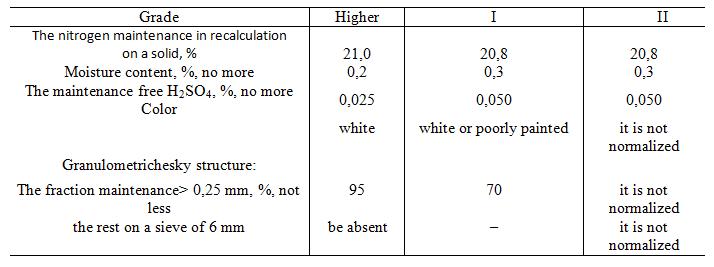
The important indicator of quality of sulphate of ammonium is the size of crystals. The Melkokristallichesky structure of salt with strongly developed surface is at the bottom of the raised maintenance in it of a moisture and sulfuric acid that leads to caking at storage and to its accretion in agglomerates. Krupnokristallichesky salt is less subject to caking and in regular intervals distributed in soil at its use as fertilizer [4].
Ammonium sulphate contains about 24 % of sulphur which in the form of a sulphate-ion arrives in soil together with fertilizer. Ammonium sulphate is fertilizer for agricultural fields. Value of this fertilizer is caused by the high maintenance of nitrogen, in comparison with other nitric fertilizers (the Chilean saltpeter NaNO3 containing 15–16 %, the Norwegian saltpeter Ca (NO3) 2, containing 13–14 % and the natural fertilizer containing 6–7 % of nitrogen); nitrogen is well acquired from soil by roots of plants. Containing in sulphate of ammonium sulphur is a necessary element of a food for many agricultural crops (a beet, a cotton, tobacco, etc.), therefore it is possible to consider ammonium sulphate as the fertilizer, containing nutrients more than 45 % and possessing high agrotechnical properties [2].
Ammonium sulphate is made on chemical-recovery factories in considerable quantities. On 1 t dry batch manufacture of sulphate of ammonium (dry) makes 11,0–11,5 kg [5].
Productivity of a dryer on a crude material [9]:

where GK - productivity of a dryer on the dried up material
Quantity of an evaporated moisture:

Heat expense

where Qисп – warmly spent for moisture evaporation,
Qнаг – warmly spent for material heating,
Qпот – heat losses in the environment, accepted equal 15 % from first two composed,
r0 – warmth of evaporation at 0°С,
cп – thermal capacity of water steam,
cм – material thermal capacity,
tм1 – material temperature on an input in a dryer,
tм2 – material temperature on an exit from a dryer.
The expense of dry air
where св – thermal capacity of dry air.
The specific expense of dry air:
х1 - initial moisture content of air.
Air moisture content on an exit from a dryer:
Criterion of Prandtlja:

where - heat conductivity of air
- heat conductivity of air
Viscosity of air at 90°С :

where  - viscosity of air at 0°С
- viscosity of air at 0°С
C – auxiliary factor.
Criterion of Nusselta:

Reynolds's criterion for operating conditions:

where - volume a boiling layer
- volume a boiling layer
Archimedes criterion:

where - material density
- material density
Kinematic viscosity of air:

where - air density on an exit from a dryer
- air density on an exit from a dryer
Heat exchange factor:

Number of units of carrying over:

Volume of a boiling layer:

where - specific surface
- specific surface

Layer height:
Under the practical data usually accept layer height

where  – diameter of apertures
– diameter of apertures
The general height of the device

The purpose of drawing up of the Tree of refusals is object representation in a hierarchical kind and definition of the most dangerous elements of a design and influences on it [6].
Tree of refusals (failures, incidents, the consequences, undesirable events and incidents.) underlies logiko-likelihood model of relationships of cause and effect of refusals of system with refusals of its elements and other events (influences). At the analysis of occurrence of refusal, the tree of refusals consists of sequences and combinations of infringements and malfunctions, and thus it represents multilevel graphological structure of the causal interrelations received as a result of procaking of dangerous situations upside-down to find the possible reasons their occurrence.
This way the deductive method (reasons-consequences) that allocates a method with the most serious possibilities on search of the root reasons of events for static systems as gives the evident and detailed scheme of interrelations of elements of an infrastructure and the events influencing their reliability is realised.
Value of a tree of refusals consists in the following [3]:
• the analysis is guided by a finding of refusals;
• allows to show in an explicit form unreliable places;
• it is provided with a drawing and represents an evident material for experts who take part in system service;
• gives the chance to carry out the qualitative or quantitative analysis of reliability of system;
• the method allows experts to concentrate serially on separate concrete refusals of system;
• provides deep representation about behaviour of system and penetration into process of its work;
• are means of dialogue of experts as they are presented in the accurate evident form;
• helps deductive to reveal refusals;
• gives to designers, users and heads possibility of an evident substantiation of constructive changes or an establishment of degree of conformity of a design of system to the set requirements and the analysis of conciliatory proposals;
• facilitates the analysis of reliability of difficult systems.
The main advantage of a tree of refusals (in comparison with other methods) consists that the analysis is limited to revealing only those elements of system and events which lead to the given concrete refusal of system or failure.
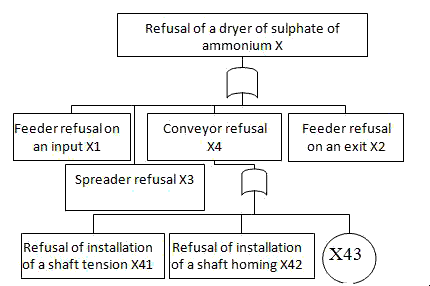
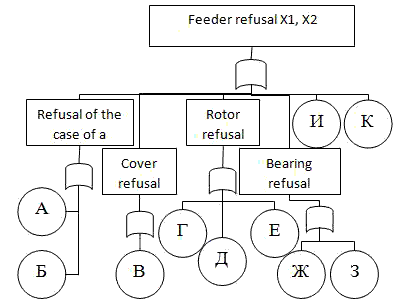 |
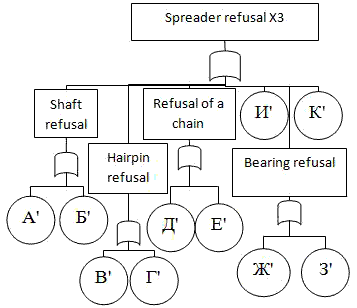 |
| b) | c) |
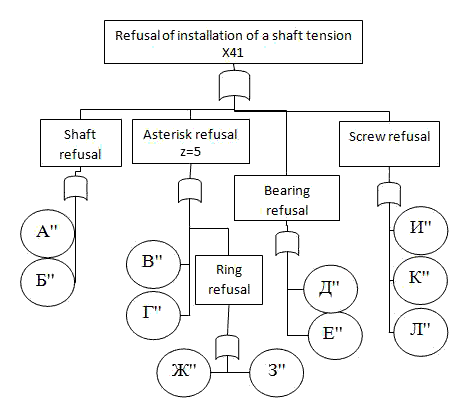 |
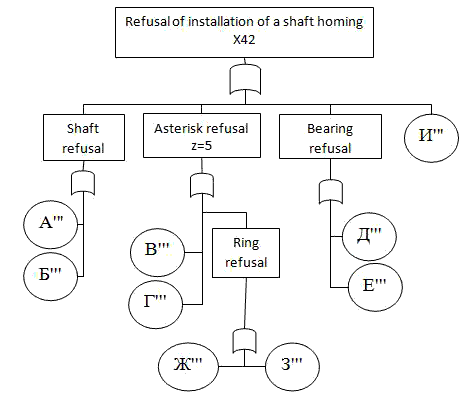 |
| d) | e) |
Feeder (Loading: Х1; Unloading: Х2. Unloading has the same code, but with an index 2): A – case deformation;Б – case corrosion; В-boltovoe cover connection; Г - bolted joint rotor connection; Д - hit of extraneous subjects in a rotor; Е – sticking;Ж – absence of greasing in the bearing; З – excess of operating loading on the bearing; И – a cut connector; К – drive refusal.
Broadcaster(Х3):А' – shaft corrosion; Б' – excess of supposed loadings; В' – deflection; Г' – hairpin cut; Д' – separation of a chain owing to degradation; Е' – hit of extraneous elements; Ж' – absence of greasing; З' – loading excess; И' – сut connectorи; К' – drive refusal.
Installation of a shaft tension(Х41): А'' - shaft corrosion; Б'' – excess of supposed pressure operating on a shaft; В'' – tooth cut; Г'' – сut connector; Д'' – absence of greasing; Е'' – excess of operating loading on the bearing; Ж'' – screw refusal; З'' – degradation of a surface of a ring; И'' – cut of a carving of the screw; К'' – refusal bolt connections; Л'' – refusal split.
Shaft installation homing(Х42): А''' – shaft corrosionа; Б''' – excess of supposed pressure operating on a shaft; В''' – tooth cut; Г''' – сut connector; Д''' – absence of greasing; Е''' – excess of operating loading on the bearing; Ж''' – screw refusal state standard specification 1487-62; З''' – degradation of a surface of a ring; И''' – refusal; Х43 – refusal of a transporting surface.







Let's consider a method «the Tree of refusals» on an example of a dryer of sulphate of ammonium in boiling a layer. The statistical data typical is taken from the help literature, and the others are calculated by corresponding techniques [3,4,6,10].
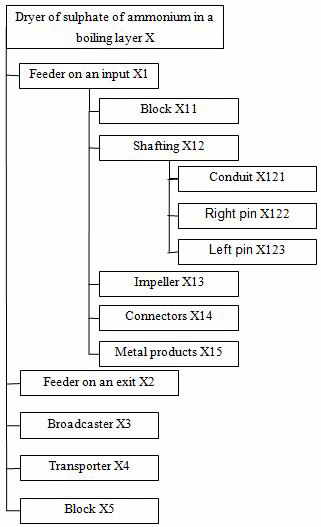
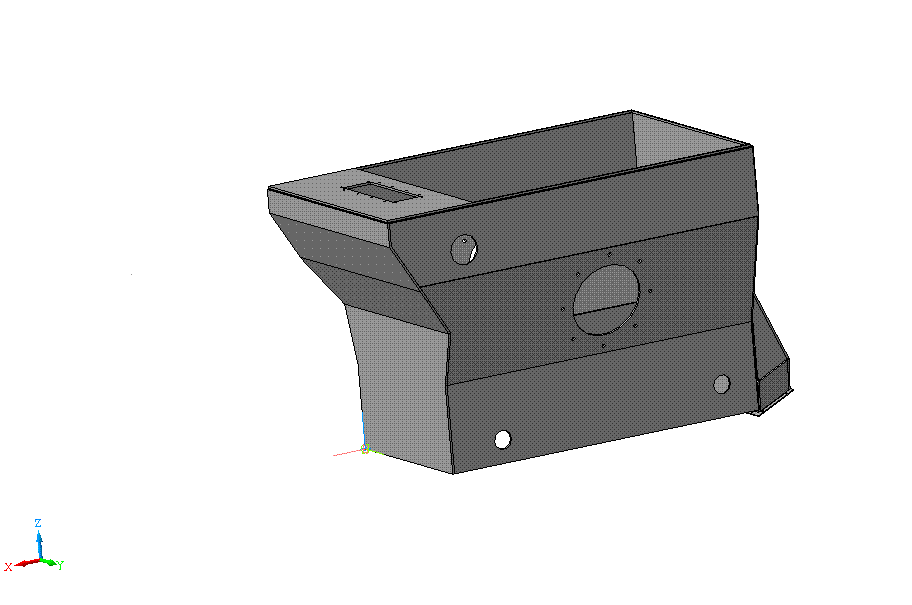
By means of the program the КОМПАС 3D V11 it is developed 3D dryer model. The model consists of 2500 details, from them unique 230.
Diagnosing of a wall of the case of a dryer of sulphate of ammonium in a boiling layer with nominal thickness of wall Sn = 10 mm is spent. The dryer is in operation since 1972 y.
In 1997 diagnosing which has shown that mechanical properties of a steel not below requirements shown to the given mark of a steel has been spent.
The gaugings of thickness spent at diagnosing are shown in the following table:
Table 2 – Gauging of a thickness

It is required to define the bottom interval estimation of a gamma percentage residual resource [11,12].



where Д[Q] – dispersion of relative deterioration
Average value of admissible relative deterioration:

The top interval values of average deterioration and it root-mean-square deviations [13]:

where Uq – quantile normal distribution. Gets out outcomes of value q, at q=0,95: Uq =1,65;
 – average quadratic deviation of relative deterioration
– average quadratic deviation of relative deterioration

Provided  , that is necessary
, that is necessary  = 0.
= 0.
Average values утонения walls and its average quadratic deviation:

where N – quantity of gaugings;
 – speed of deterioration:
– speed of deterioration:

where  -time of operation of an element at the moment of diagnosing, year;
-time of operation of an element at the moment of diagnosing, year;
α0– initial среднеквадратическое a deviation of a thickness of a wall,
 - diagnosing time when it was spentk k– gauging of a thickness of a wall
- diagnosing time when it was spentk k– gauging of a thickness of a wall

where  – deterioration in k – point;
– deterioration in k – point;
sk - current thickness of a wall in a place k – gauging, mm;
snk– nominal thickness of a wall of a diagnosed element, mm.
Otbrakovochnaja thickness of a wall of the case of a dryer Sr = 6,0 mm.
According to recommendations, we accept values of regulated reliability  = 95 % and unilateral confidential probability q = 0,95. The linear model of deterioration is accepted.
= 95 % and unilateral confidential probability q = 0,95. The linear model of deterioration is accepted.
At the moment of delivery of a site work has not been finished yet, therefore results of work not представолены. It is possible to judge prospective result only on the structure of work resulted above.